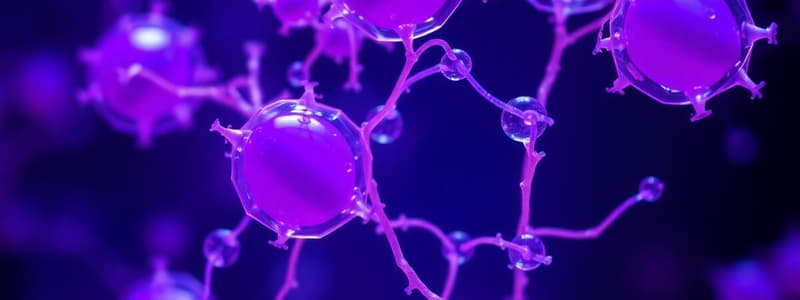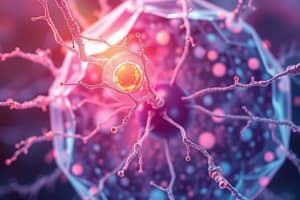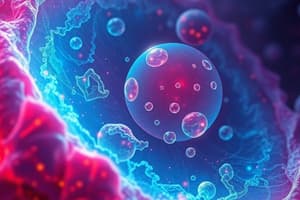Podcast
Questions and Answers
What is the main role of the cell membrane?
What is the main role of the cell membrane?
- To enable the cell to divide
- To separate and protect the cell from its surroundings (correct)
- To produce proteins
- To store genetic information
Which of the following is NOT a component of the cell membrane?
Which of the following is NOT a component of the cell membrane?
- Carbohydrates
- Cellulose (correct)
- Phospholipids
- Proteins
What is the function of the carbohydrates embedded in the cell membrane?
What is the function of the carbohydrates embedded in the cell membrane?
- To act as channels for transport
- To act as chemical ID cards (correct)
- To generate energy
- To provide structural support
What is the primary function of the cell wall in plants?
What is the primary function of the cell wall in plants?
What is the main component of the cell wall in plants?
What is the main component of the cell wall in plants?
Which of the following organelles is responsible for generating cellular energy?
Which of the following organelles is responsible for generating cellular energy?
What is the name of the pigment found in chloroplasts that captures light energy?
What is the name of the pigment found in chloroplasts that captures light energy?
Which of the following is the best description of the fluid-mosaic model?
Which of the following is the best description of the fluid-mosaic model?
Which of the following is NOT a function of the Golgi apparatus?
Which of the following is NOT a function of the Golgi apparatus?
Which type of ER has ribosomes attached to it?
Which type of ER has ribosomes attached to it?
Which of the following organelles are involved in cell division?
Which of the following organelles are involved in cell division?
Which of the following is a function of lysosomes?
Which of the following is a function of lysosomes?
Which of the following is NOT a characteristic of a prokaryote?
Which of the following is NOT a characteristic of a prokaryote?
Which of the following organelles is responsible for the detoxification of cells?
Which of the following organelles is responsible for the detoxification of cells?
What is the primary function of the cytoskeleton?
What is the primary function of the cytoskeleton?
What is the function of vacuoles in plant cells?
What is the function of vacuoles in plant cells?
Who was the first person to observe living cells through a simple microscope?
Who was the first person to observe living cells through a simple microscope?
What did Robert Hooke observe in cork that led to the discovery of plant cells?
What did Robert Hooke observe in cork that led to the discovery of plant cells?
Which scientist concluded that all living things are composed of cells?
Which scientist concluded that all living things are composed of cells?
What does the cell theory state regarding the origin of cells?
What does the cell theory state regarding the origin of cells?
Which of the following statements is NOT a characteristic of living things?
Which of the following statements is NOT a characteristic of living things?
What is the basic unit of structure and function in all living organisms?
What is the basic unit of structure and function in all living organisms?
Which scientist hypothesized that new cells do not form on their own?
Which scientist hypothesized that new cells do not form on their own?
Cells in multicellular organisms are organized into which of the following structures?
Cells in multicellular organisms are organized into which of the following structures?
What is a defining characteristic of prokaryotic cells?
What is a defining characteristic of prokaryotic cells?
Which of the following is NOT a component of all cells?
Which of the following is NOT a component of all cells?
What process do prokaryotic cells primarily use to reproduce?
What process do prokaryotic cells primarily use to reproduce?
Which of the following correctly distinguishes prokaryotic from eukaryotic cells?
Which of the following correctly distinguishes prokaryotic from eukaryotic cells?
Which component of the cell theory states that all living organisms are composed of cells?
Which component of the cell theory states that all living organisms are composed of cells?
What function does the cell membrane serve?
What function does the cell membrane serve?
Which of the following statements is true about eukaryotic cells?
Which of the following statements is true about eukaryotic cells?
Which structure is common to both plant and animal cells?
Which structure is common to both plant and animal cells?
Flashcards
Cells
Cells
The fundamental building blocks of life, responsible for structure and function in all living organisms.
Anton Van Leeuwenhoek
Anton Van Leeuwenhoek
Dutch biologist who used a simple microscope to observe living cells for the first time.
Robert Hooke
Robert Hooke
English scientist who observed dead plant cells in a slice of cork and coined the term 'cell'.
Matthias Schleiden
Matthias Schleiden
Signup and view all the flashcards
Theodor Schwann
Theodor Schwann
Signup and view all the flashcards
Rudolph Virchow
Rudolph Virchow
Signup and view all the flashcards
Cell Theory
Cell Theory
Signup and view all the flashcards
Cell Biology
Cell Biology
Signup and view all the flashcards
Organ System
Organ System
Signup and view all the flashcards
Prokaryotic Cell
Prokaryotic Cell
Signup and view all the flashcards
Eukaryotic Cell
Eukaryotic Cell
Signup and view all the flashcards
Binary Fission
Binary Fission
Signup and view all the flashcards
Cell Membrane
Cell Membrane
Signup and view all the flashcards
Cytoplasm
Cytoplasm
Signup and view all the flashcards
DNA
DNA
Signup and view all the flashcards
What is the cell membrane?
What is the cell membrane?
Signup and view all the flashcards
What is the fluid-mosaic model?
What is the fluid-mosaic model?
Signup and view all the flashcards
What is the cell wall?
What is the cell wall?
Signup and view all the flashcards
What does the cell wall do?
What does the cell wall do?
Signup and view all the flashcards
What is the nucleus?
What is the nucleus?
Signup and view all the flashcards
What are mitochondria?
What are mitochondria?
Signup and view all the flashcards
What are plastids?
What are plastids?
Signup and view all the flashcards
What are chloroplasts?
What are chloroplasts?
Signup and view all the flashcards
What is a prokaryote?
What is a prokaryote?
Signup and view all the flashcards
Does a prokaryote have a cell membrane?
Does a prokaryote have a cell membrane?
Signup and view all the flashcards
What's the function of the Rough ER?
What's the function of the Rough ER?
Signup and view all the flashcards
What does the Golgi apparatus do?
What does the Golgi apparatus do?
Signup and view all the flashcards
What is the function of lysosomes?
What is the function of lysosomes?
Signup and view all the flashcards
What are vacuoles?
What are vacuoles?
Signup and view all the flashcards
What is the role of the cytoskeleton?
What is the role of the cytoskeleton?
Signup and view all the flashcards
Why are centrioles important?
Why are centrioles important?
Signup and view all the flashcards
Study Notes
Introduction to Cells
- Cells are the basic units of structure and function in all living things.
Discovery of Cells
- Anton van Leeuwenhoek (1632-1723): Dutch biologist, first person to observe living cells through a simple microscope.
- Robert Hooke (1635-1703): Examined cork cells, and coined the term "cell" describing the compartments.
- Robert Brown: Observed a dark circle in the center of the cell, which was later named the nucleus.
Development of Cell Theory
- Matthias Schleiden (1838): German scientist, observed plant parts using a microscope; concluded that all plants are made of cells.
- Theodor Schwann (1839): German scientist, observed many different animal cells; concluded that all animals are made of cells.
- Rudolph Virchow (mid-1800s): German physician; hypothesized that new cells are formed from pre-existing cells.
Cell Theory
- All living things are composed of one or more cells.
- Cells are the basic units of structure and function in living organisms.
- New cells are produced from pre-existing cells.
Developments in Cell Biology
- Microscopes clarified the definition of life.
- All living things consist of organized parts, obtain and use energy, perform chemical reactions, change over time, maintain homeostasis, respond to their environment, reproduce, and share a common history.
Cell Diversity
- Not all cells are identical.
- Cells within an organism exhibit diverse size, shape, and organization variations.
- This diversity is related to the variety of cell functions.
Cell Organization
- Tissues: groups of cells that carry out specific functions (e.g., epithelial tissue, muscle tissue).
- Organs: several types of tissues interacting to perform a specific function (e.g., stomach).
- Organ systems: groups of organs working together to perform a set of related tasks (e.g., digestive system).
Prokaryotic Cells
- Unicellular organisms.
- Lack a nucleus and membrane-bound organelles. The genetic material is concentrated in a nucleoid region.
- Can be concentrated in one part of the cell.
- Can have flagella for movement or pili/fimbriae for attaching to surfaces.
- Reproduce by binary fission. Examples: E. coli, Streptococcus.
Eukaryotic Cells
- Contain a membrane-bound nucleus and organelles.
- Examples include plant and animal cells.
Cell Facts
- Cells cannot survive if isolated from their environment.
- Cells need nutrients to survive.
- Cells eliminate waste.
- Most cells are only visible using a microscope.
Organelles
- Organelles are cell components that perform specific functions.
Cell Structures
- All cells have
- Cell membrane: outer boundary of the cell.
- DNA: genetic information
- Cytoplasm: watery material inside the cell membrane; contains dissolved substances, enzymes, organelles, and structures.
Prokaryotic vs. Eukaryotic Cells
- This is a comparison highlighting the key structural differences.
Cell Wall
- Found in plants, algae, some bacteria, and fungi.
- Surrounds the cell membrane.
- Protects and supports the cell
- Made of cellulose in plants.
- Has primary and secondary layers.
Nucleus
- One of the largest organelles.
- Surrounded by a nuclear envelope with nuclear pores, a membrane.
- Contains a nucleolus, a dense region with RNA and proteins, which are essential for ribosome production.
- Contains the chromosomes that hold the genetic information.
- Is the information center of the cell, directing most of the cell activities.
Cytoplasm
- Contains structures called organelles.
- Primarily composed of water.
Mitochondria
- Has two membranes.
- Used to generate cellular energy (ATP) through cellular respiration.
- Inner membrane has folds called cristae.
- Contains their own DNA and ribosomes.
Plastids
- Found in plant cells
- Store food and pigments.
- Amyloplasts: store starch
- Leucoplasts: store food
- Chromoplasts: store pigments like carotenoids (orange).
- Chloroplasts: conduct photosynthesis.
Chloroplast
- Photosynthetic organelle (found in plant cells).
- Has two outer membranes and one inner thylakoid membrane
- Interior fluid is called stroma
- Changes energy from sunlight into stored chemical energy.
- Contains pigment chlorophyll.
Vacuoles
- Sac-like storage structures.
- Store enzymes and waste products.
- Very large in plant cells; aid in plant growth and support.
Cytoskeleton
- Network of filaments and fibers that support cell structure and movement.
- Types: microtubules, microfilaments, and intermediate filaments.
- Includes cilia and flagella.
Centrioles
- Cylindrical organelles found only in animal cells.
- Involved in cell division.
- Starting place for microtubules.
- Always occur in pairs
Endosymbiotic Theory
- eukaryotic cells evolved from prokaryotic cells through engulfing of prokaryotes, particularly mitochondria and chloroplasts.
Studying That Suits You
Use AI to generate personalized quizzes and flashcards to suit your learning preferences.





